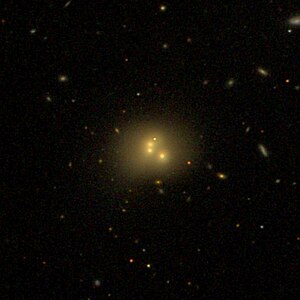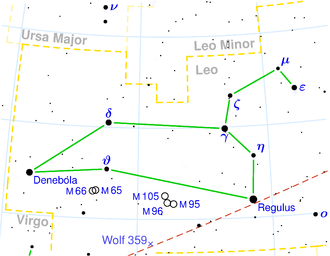NGC 3492
| Galaxy NGC 3492 |
|
|---|---|

|
|
| SDSS recording | |
| AladinLite | |
| Constellation | lion |
|
Position equinox : J2000.0 , epoch : J2000.0 |
|
| Right ascension | 11 h 00 m 57.0 s |
| declination | + 10 ° 30 ′ 18 ″ |
| Appearance | |
| Morphological type | E + E |
| Brightness (visual) | 1: 13.2 mag 2: 15.0 mag |
| Brightness (B-band) | 1: 14.2 mag 2: 16.0 mag |
| Angular expansion | 1: 1.1 ′ × 0.7 ′ 2: 0.5 ′ × 0.5 ′ |
| Position angle | 1: 100 ° |
| Surface brightness | 1: 13.0 mag / arcmin² 2: 13.6 mag / arcmin² |
| Physical data | |
| Affiliation | Abell 1142 |
| Redshift | 0.036272 ± 0.000147 |
| Radial velocity | (10874 ± 44) km / s |
|
Stroke distance v rad / H 0 |
(481 ± 34) · 10 6 ly (147.6 ± 10.3) Mpc |
| history | |
| discovery | Christian Peters |
| Discovery date | 1880 |
| Catalog names | |
| NGC 3492 • UGC 6094 • PGC 33207/83429 • CGCG 066-093 • MCG + 02-28-045 • | |
NGC 3492 is an interacting galaxy pair (triplet?) In the constellation Leo. It is an estimated 481 million light years from the Milky Way .
The object was discovered in 1880 by Christian Heinrich Friedrich Peters .
